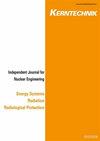COCOSYS安全壳规范系统中爆燃模型的扩展方法,通过结点分离燃烧和未燃烧的大气
IF 0.4
4区 工程技术
Q4 NUCLEAR SCIENCE & TECHNOLOGY
引用次数: 0
摘要
摘要在水冷核电站发生严重事故的情况下,大量的氢(H2)和一氧化碳(CO)会产生并释放到安全壳或反应堆建筑中,如果没有被动的自催化重组器,它们可能与空气形成可燃混合物。在点火的情况下,可能会出现压力峰值,这与安全相关设备和安全壳或反应堆建筑物的完整性有关。因此,能够正确预测可能发生的燃烧现象对于安全分析非常重要。事故分析代码AC2 2021.0是由Gesellschaft fr Anlagen- und Reaktorsicherheit (GRS)开发的,其中包括用于模拟安全壳现象的安全壳代码系统(COCOSYS版本3.1)。COCOSYS包含用于模拟H2和CO预混爆燃的FRONT模型。最近在多室THAI+测试设施中进行的H2爆燃测试验证代码表明,在模拟某些测试中火焰传播提前停止。这在一定程度上是由于未将燃烧的大气和未燃烧的大气分离,导致与燃烧区相连的尚未燃烧区的燃料浓度降低。确定了模型改进的潜力,并在本文中进行了讨论。提出了一种模型扩展,通过结点模型来分离燃烧和未燃烧的大气,并在COCOSYS 3.1的开发版本中实现。讨论了使用THAI测试HD-39的首次验证结果,表明扩展模型提高了预测能力。本文章由计算机程序翻译,如有差异,请以英文原文为准。
An approach for an extension of the deflagration model in containment code system COCOSYS to separate burned and unburned atmosphere via junctions
Abstract In case of a postulated severe accident in a water-cooled nuclear power plant significant amounts of hydrogen (H2) and carbon monoxide (CO) can be generated and released into the containment or reactor building where it might form a combustible mixture with air assuming passive autocatalytic recombiners are not available. In case of ignition, pressure peaks might occur, that are relevant for the integrity of safety relevant equipment and the containment or reactor building. It is therefore important for safety analysis to be able to correctly predict combustion phenomena that might occur. The accident analysis code AC2 2021.0 which is developed by Gesellschaft für Anlagen- und Reaktorsicherheit (GRS) includes the Containment Code System (COCOSYS version 3.1) for the simulation of containment phenomena. COCOSYS contains the model FRONT for the simulation of premixed deflagration of H2 and CO. Recent code validation using H2 deflagration tests conducted in the multi-compartment THAI+ test facility shows that the flame propagation stops prematurely in simulations of some tests. This is partly attributed to the missing separation of burned and unburned atmosphere which leads to a reduction in fuel concentration in not yet burning zones connected to a burning zone. Model improvement potential was identified which is addressed in this paper. A model extension to separate burned and unburned atmosphere via a junction model is proposed and implemented into a development version of COCOSYS 3.1. First validation results using the THAI test HD-39 are discussed that show improved prediction capability by the extended model.
求助全文
通过发布文献求助,成功后即可免费获取论文全文。
去求助
来源期刊

Kerntechnik
工程技术-核科学技术
CiteScore
0.90
自引率
20.00%
发文量
72
审稿时长
6-12 weeks
期刊介绍:
Kerntechnik is an independent journal for nuclear engineering (including design, operation, safety and economics of nuclear power stations, research reactors and simulators), energy systems, radiation (ionizing radiation in industry, medicine and research) and radiological protection (biological effects of ionizing radiation, the system of protection for occupational, medical and public exposures, the assessment of doses, operational protection and safety programs, management of radioactive wastes, decommissioning and regulatory requirements).
 求助内容:
求助内容: 应助结果提醒方式:
应助结果提醒方式:


